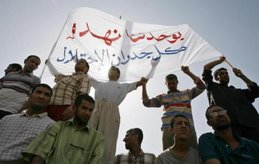CBC News - World - The continuing plight of Iraq's refugees
Last Updated: Friday, July 16, 2010 | 3:01 PM ET Comments20Recommend15
By Oussayma Canbarieh, special to CBC News
Zakiya is sitting in the modest living room of her rented two-bedroom apartment in Jaramana, a small neighbourhood on the outskirts of Damascus that has become known as "Little Baghdad" for its high concentration of Iraqi refugees.
The 44-year-old mother of three likes to skim through her photo albums from time to time and remember her old life in the now battered Iraqi capital.
 Zakiya, an Iraqi refugee in Syria, shows her UN certificate, which allows her a stipend of about $200 a month. (Oussayma Canbarieh/CBC)
Zakiya, an Iraqi refugee in Syria, shows her UN certificate, which allows her a stipend of about $200 a month. (Oussayma Canbarieh/CBC) As she shows off the family pictures from before the war, she suddenly starts sobbing.
"Look at me here, I used to be happy," she says. "Now, I've lost it all."
Before the Americans and their allies invaded Iraq in March 2003, Zakiya was working as a journalist in Baghdad and her husband had a gold business.
But since the war, she lost her home and many of her loved ones.
"First, two of my daughters were killed and, a couple of months ago, my husband went back to Baghdad to get us some of our savings and he never came back."
Zakiya now takes care of her three remaining children, Huda, 12, and nine-year-old twins Hassan and Noor.
She lives off her savings and receives a food basket as well as a $200 monthly cheque from the UN's refugee agency.
Guests of a sort
Zakiya's situation is far from unique. The U.S.-led war has created millions of Iraqi refugees who have tried to escape the ensuing violence by seeking new lives across the Middle East and, in some cases, Europe and North America.
By some estimates, nearly five million Iraqis have been displaced by the war, a figure that is said to represent nearly 40 per cent of the country's former middle class.
Because of Syria's geographic proximity — and a welcoming policy — the majority have settled here, almost 1.1 million by the latest estimate.
Since there are no refugee camps in Syria per se, settlers are mainly concentrated in two low-rent suburbs of Damascus: Jaramana and Sayeda Zainab.
Most of these new arrivals have been living off their savings. But, as time went by, their bank accounts have been drying up and they have come to face the classic refugee squeeze: As refugees, they are not allowed to work in the country, but if they don't work, they can't make ends meet.
The result is that many have no choice but to work illegally at low-paying jobs, while those who are well off have opened up businesses that cater specifically to the growing Iraqi community in Jaramana.
"Competition is fierce among transportation services that offer bus rides from Damascus to Baghdad," says 35-year-old Karim, who would know as he is in this business himself.
Zakiya is a regular customer at the famous Qassim restaurant in Jaramana, which is where many Iraqis like to gather once a day over lunch, a water pipe or a game of cards.
"I feel a sense of comfort hearing familiar accents and reminiscing of life in Baghdad over a cup of tea," she says.









